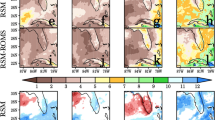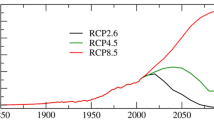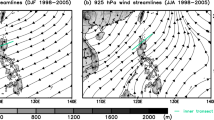Abstract
A comparative analysis of two sets of downscaled simulations of the current climate and the future climate projections over Peninsular Florida (PF) and the West Florida Shelf (WFS) is presented to isolate the role of high-resolution air-sea coupling. In addition, the downscaled integrations are also compared with the much coarser, driving global model projection to examine the impact of grid resolution of the models. The WFS region is habitat for significant marine resources, which has both commercial and recreational value. Additionally, the hydroclimatic features of the WFS and PF contrast each other. For example, the seasonal cycle of surface evaporation in these two regions are opposite in phase to one another. In this study, we downscale the Community Climate System Model version 4 (CCSM4) simulations of the late twentieth century and the mid-twenty-first century (with reference concentration pathway 8.5 emission scenario) using an atmosphere only Regional Spectral Model (RSM) at 10 km grid resolution. In another set, we downscale the same set of CCSM4 simulations using the coupled RSM-Regional Ocean Model System (RSMROMS) at 10 km grid resolution. The comparison of the twentieth century simulations suggest significant changes to the SST simulation over WFS from RSMROMS relative to CCSM4, with the former reducing the systematic errors of the seasonal mean SST over all seasons except in the boreal summer season. It may be noted that owing to the coarse resolution of CCSM4, the comparatively shallow bathymetry of the WFS and the sharp coastline along PF is poorly defined, which is significantly rectified at 10 km grid spacing in RSMROMS. The seasonal hydroclimate over PF and the WFS in the twentieth century simulation show significant bias in all three models with CCSM4 showing the least for a majority of the seasons, except in the wet June-July-August (JJA) season. In the JJA season, the errors of the surface hydroclimate over PF is the least in RSMROMS. The systematic errors of surface precipitation and evaporation are more comparable between the simulations of CCSM4 and RSMROMS, while they differ the most in moisture flux convergence. However, there is considerable improvement in RSMROMS compared to RSM simulations in terms of the seasonal bias of the hydroclimate over WFS and PF in all seasons of the year. This suggests the potential rectification impact of air-sea coupling on dynamic downscaling of CCSM4 twentieth century simulations. In terms of the climate projection in the decades of 2041–2060, the RSMROMS simulation indicate significant drying of the wet season over PF compared to moderate drying in CCSM4 and insignificant changes in the RSM projection. This contrasting projection is also associated with projected warming of SSTs along the WFS in RSMROMS as opposed to warming patterns of SST that is more zonal and across the WFS in CCSM4.









Similar content being viewed by others
References
Adler RF, Huffman GJ, Bolvin DT, Curtis S, Nelkin EJ (2000) Tropical rainfall distributions determined using TRMM combined with other satellite and rain gauge information. J Appl Meteorol 39(12):2007–2023
Alpert J, Kanamitsu M, Caplan P, Sela J, White G (1988) Mountain induced gravity wave drag parameterization in the NMC medium-range forecast model. In Conference on Numerical Weather Prediction, 8th, Baltimore, MD. 726–733
Boyer TP, Stephens C, Antonov JI, Conkright ME, Locarnini LA, O’Brien TD, Garcia HE (2002) Salinity. NOAA Atlas NESDIS 49 2:165 pp World Ocean Atlas 2001
Carlson E (2012) Population trends in Florida, 2000 to 2030. In Climate Scenarios: A Florida-Centric View, ed. V. Misra, Available from:http://floridaclimate.org/climate_scenario_pdf.php
Carton JA, Giese BS (2008) A reanalysis of ocean climate using Simple Ocean Data Assimilation (SODA). Mon Weather Rev 136(8):2999–3017
Chan S, Misra V (2011) Dynamic downscaling of the North American with the ECPC-NCEP Regional Spectral Model from NCEP CFS global model-varied representation. J Climate 24:653–673
Chang YL, Oey LY (2010) Why can wind delay the shedding of Loop Current eddies? J Phys Oceanogr 40(11):2481–2495
Chou MD, Lee KT (1996) Parameterizations for the absorption of solar radiation by water vapor and ozone. J Atmos Sci 53:1203–1208
Chou MD, Lee KT, Tsay SC, Fu Q (1999) Parameterization for cloud longwave scattering for use in atmospheric models. J Clim 12(1):159–169
Dixon LK, Kirkpatrick GJ, Hall ER, Nissanka A (2014) Nitrogen, Phosphorous, and Silica on the west Florida shelf: patterns and relationships with Karenia spp. Occurrence Harmful Algae 38:8–19. https://doi.org/10.1016/j.hal.2014.07.001
Ek MB, Mitchell KE, Lin Y, Rogers E, Grunmann P, Koren V, Gayno G, Tarpley JD (2003) Implementation of Noah land surface model advances in the National Centers for Environmental Prediction operational mesoscale Eta model. J Geophys Res 108:22
Feser F, Burkhardt R, von Storch H, Winterfeldt J, Zahn M (2011) Regional climate models add value to global model data. Bull Am Soc. https://doi.org/10.1175/2011BAMS3061.1
Gent PR, Danabasoglu G, Donner LJ, Holland MM, Hunke EC, Jayne SR, Lawrence DM, Neale RB, Rasch PJ, Vertenstein M, Worley PH (2011) The community climate system model version 4. J Clim 24(19):4973–4991
Giorgi F, Gutowski WJ Jr (2015) Regional dynamical downscaling and the CORDEX initiative. Annu Rev Environ Resour 40:467–490
Haidvogel DB, Arango HG, Hedstrom K, Beckmann A, Malanotte-Rizzoli P, Shchepetkin AF (2000) Model evaluation experiments in the North Atlantic Basin: simulations in nonlinear terrain-following coordinates. Dynam Atmos Oceans 32(3):239–281
He R, Weisberg RH, Zhang H, Muller-Karger FE, Helber RW (2003) A cloud free, satellite derived, sea surface temperature analysis for the West Florida Shelf. Geophys Res Lett. https://doi.org/10.1029/2003GL017673
Heil CA, Bronk DA, Dixon LK, Hitchcock L et al (2014) The Gulf of Mexico (ECOHAB): Karenia program 2006–2012. Harmful Algae 38:3–7. https://doi.org/10.1016/j.hal.2014.07.015
Hewitson BC, Crane RG (1996) Climate downscaling: techniques and application. Clim Res 5:85–95
Hong SY, Pan HL (1996) Nonlocal boundary layer vertical diffusion in a medium-range forecast model. Mon Weather Rev 124(10):2322–2339
Huffman GJ, Adler RF, Rudolf B, Schneider U, Keehn PR (1995) Global precipitation estimates based on a technique for combining satellite-based estimates, rain gauge analysis, and NWP model precipitation information. J Clim 8(5):1284–1295
Huffman GJ, Adler RF, Arkin P, Chang A, Ferraro R, Gruber A, Janowiak J, McNab A, Rudolf B, Schneider U (1997) The global precipitation climatology project (GPCP) combined precipitation dataset. Bull Am Meteor Soc 78(1):5–20
Juang HM, Kanamitsu M (1994) The NMC nested regional spectral model. Mon Weather Rev 122:3–26
Kanamitsu M, Yoshimura K, Yhang YB, Hong SY (2010) Errors of interannual variability and trend in dynamical downscaling of reanalysis. J Geophys Res 115:17
Kirtman B, Bitz C, Bryan F et al (2012) Impact of ocean model resolution on CCSM climate simulations. Clim Dyn 39:1303–1328. https://doi.org/10.1007/s00382-012-1500-3
Kirtman BP, Perlin N, Siqueira L (2017) Ocean eddies and climate predictability. Chaos Interdiscip J Nonlinear Sci 27:126902. https://doi.org/10.1063/1.4990034
Large WG, McWilliams JC, Doney SC (1994) Oceanic vertical mixing: a review and a model with a nonlocal boundary layer parameterization. Rev Geophys 32(4):363–403
Laurindo LC, Siqueira L, Mariano AJ, Kirtman BP (2018) Cross-spectral analysis of the SST/10-m wind speed coupling resolved by satellite products and climate model simulations. Clim Dyn Submitt
Li H, Kanamitsu M, Hong SY (2012) California reanalysis downscaling at 10 km using an ocean -atmosphere coupled regional model system. J Geophys Res 117:12
Liu Y, Weisberg RH (2012) Seasonal variability on the West Florida Shelf. Prog Oceanogr 104:80–98
Liu Y, Lee SK, Muhling BA, Lamkin JT, Enfield DB (2012) Significant reduction of the loop current in the 21st century and its impact on the Gulf of Mexico. J Geophys Res 117:C05039. https://doi.org/10.1029/2011JC007555
Liu H, Wang C, Lee SK, Enfield DB (2013) Atlantic warm pool variability in the CMIP5 simulations. J Clim 26:5315–5336. https://doi.org/10.1175/JCLI-D-12-00556.1
Liu Y, Lee SK, Enfield DB, Muhling BA, Lamkin JT, Muller-Karger FE, Roffer MA (2015) Potential impact of climate change on the intra-Americas Sea: part-1. A dynamic downscaling of the CMIP5 model projections. J Mar Syst 148:56–69
Mellor GL, Yamada T (1982) Development of a turbulence closure model for geophysical fluid problems. Rev Geophys 20(4):851–875
Misra V (2005) Simulation of the intraseasonal variance of the South American summer monsoon. Mon Weather Rev 133(3):663–676
Misra V, Dirmeyer PA (2009) Air, sea, and land interactions of the continental US hydroclimate. J Hydrometeorol 10(2):353–373
Misra V, Kanamitsu M (2004) Anomaly Nesting: a methodology to dowscale seasonal climate climate simulations from an AGCM. J Clim 17:3249–3262
Misra V, Mishra A (2016) The oceanic influence on the rainy season of Peninsular Florida. J Geophys Res 121(13):7691–7709
Misra V, DiNapoli S, Bastola S (2013) Dynamic downscaling of the 20th century reanalysis over the southeastern United States. Reg Env Change 13:15–23. https://doi.org/10.1007/s00382-012-0372-8
Misra V, Mishra A, Li H (2016) The sensitivity of the regional coupled ocean-atmosphere simulations over the Intra-Americas seas to the prescribed bathymetry. Dynam Atmos Oceans 76:29–51
Misra V, Mishra A, Bhardwaj A (2017) High -resolution regional -coupled ocean–atmosphere simulation of the Indian Summer Monsoon. Int J Climatol. https://doi.org/10.1002/joc5034
Misra V, Mishra A, Bhardwaj A, Viswanathan K, Schmutz D (2018) The potential role of land cover on secular changes of the hydroclimate of Peninsular Florida. NPJ Clim Atmos Sci. https://doi.org/10.1038/s41612-018-0016-x
Moorthi S, Suarez MJ (1992) Relaxed Arakawa-Schubert. A parameterization of moist convection for general circulation models. Mon Weather Rev 120(6):978–1002
Rummukainen M (2010) State-of-the-art with regional climate models. WIREs Clim Change 1:82–96
Shchepetkin AF, McWilliams JC (2005) The regional oceanic modeling system (ROMS): a split-explicit, free-surface, topography-following-coordinate oceanic model. Ocean Modelling 9(4):347–404
Shukla J, Hagedorn R, Hoskins B, Kinter J, Marotzke J, Miller M, Palmer TN, Slingo J (2009) Revolution in climate prediction is both necessary and possible: a declaration at the world modelling summit for climate prediction. Bull Am Meteol Soc 2:175–178
Siqueira L, Kirtman BP (2016) Atlantic near-term climate variability and the role of a resolved Gulf Stream. Geophys Res Lett 43:3964–3972. https://doi.org/10.1002/2016GL068694
Smith SK (2005) Florida Population Growth: Past, Present and Future. Research Report by the Bureau of Economic and Business Research, University of Florida. Retrieved from: https://www.bebr.ufl.edu/sites/default/files/Research%20Reports/FloridaPop2005_0.pdf
Steidinger KA (1975) Basic factors influencing red tides. Florida Department of Natural Resources Marine Research Laboratory, 153–162
Suarez M, Bacmeister J (2015) Development of the GEOS-5 atmospheric general circulation model: evolution from MERRA to MERRA2. Geosci. Model Dev 8:1339–1356. https://doi.org/10.5194/gmd-8-1339-2015
Tatsumi Y (1986) A spectral limited area model with time dependent lateral boundary conditions and its application to a multi-level primitive equation model. J Meteor Soc Japan 64:637–663
Tiedtke M (1983) The sensitivity of the time-mean large-scale flow to cumulus convection in the ECMWF model. In: Proceedings of ECMWF Workshop on Convective in Large-scale Models. European Centre for Medium-Range Weather Forecasts, Reading, United Kingdom. 297–316
Tolbert WH, Salsman GG (1964) Surface circulation of the eastern Gulf of Mexico as determined by drift bottled studies. J Geophys Res 69:223–230
Umlauf L, Burchard H (2003) A generic length-scale equation for geophysical turbulence models. J Mar Res 61(2):235–265
van Vuuren DP, Edmonds JA, Kainuma M et al (2011) A special issue on the RCPs. Clim Change 109:1–4. https://doi.org/10.1007/s10584-011-0157-y
Weisberg RH, He R, Kirkpatrick G, Muller-Karger F, Walsh JJ (2004) A West Florida Shelf case study: coastal ocean circulation on remotely sensed, Oceanography, 70–75
Weisberg RH, Zheng L, Liu Y (2016a) West Florida shelf upwelling: Origins and pathways. J Geophys Res Oceans 121:5672–5681. https://doi.org/10.1002/2015JC011384
Weisberg RH, Zheng L, Liu Y (2016b) West Florida shelf upwelling: Origins and pathways. J Geophys Res (oceans) 121:56772–5681
Wilby RL, Wigley TM (1997) Downscaling general circulation model output: a review of methods and limitations. Prog Phys Geogr 21(4):530–548
Wilks D (2011) Statistical methods in the atmospheric sciences. 3rd edn, Int Geophys Ser 100: 704 pp
Yang H, Weisberg RH (1999) West Florida continental shelf circulation response to climatological wind forcing. J Geophys Res 104:5301–5320
Zhao Q, Carr FH (1997) A prognostic cloud scheme for operational NWP models. Mon Weather Rev 125(8):1931–1953
(2014) The Gulf of Mexico ECOHAB: Karenia Program 2006–2012, Harmful Algae, 38, 3–7, https://doi.org/10.1016/j.hal.2014.07.015
Acknowledgements
This work was supported by NOAA grant NA12OAR4310078 and the South Florida Water Management District (PO 039231). The authors have no conflicts of interest to declare.
Author information
Authors and Affiliations
Corresponding author
Additional information
Publisher’s Note
Springer Nature remains neutral with regard to jurisdictional claims in published maps and institutional affiliations.
Rights and permissions
About this article
Cite this article
Bhardwaj, A., Misra, V. The role of air-sea coupling in the downscaled hydroclimate projection over Peninsular Florida and the West Florida Shelf. Clim Dyn 53, 2931–2947 (2019). https://doi.org/10.1007/s00382-019-04669-5
Received:
Accepted:
Published:
Issue Date:
DOI: https://doi.org/10.1007/s00382-019-04669-5




